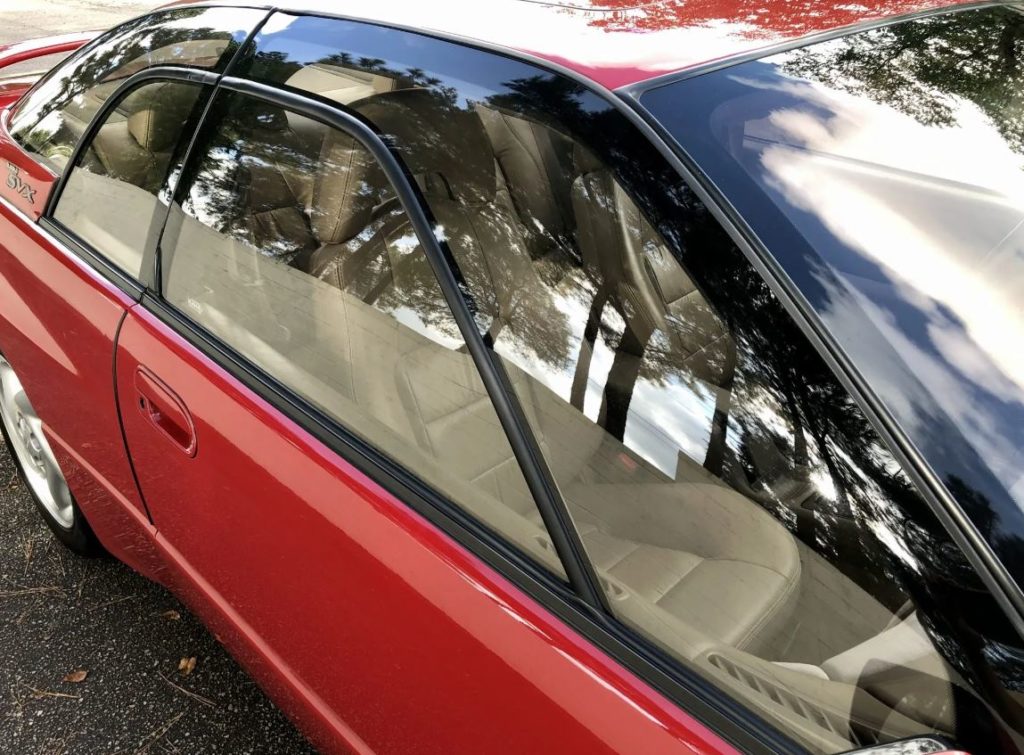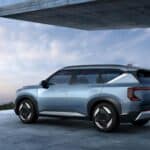Breaking the mold in the world of automotive uniformity, Subaru unveiled a unique creation in the early ’90s—the Subaru SVX. It’s the unsung hero of the Japanese Domestic Market (JDM), an oddball that dared to be different in a sea of sports car legends. As I dive into the saga of the SVX, think of it as a rare gem that, despite its initial obscurity, deserves a second look.

Teenage fans of the Subaru SVX were lonely people
As a teenager in the nineties, my buddies and I all had car posters tacked to our bedroom walls. Mostly they were Porsches, Lambos, Ferraris, and a few Corvettes. But I was alone in having an SVX on my wall. Why did I elevate the SVX to such a status? Idk. To me it was weird, unusual, quirky, and cool. I guess that’s why.
The SVX, or Subaru Vehicle X, burst onto the scene in 1992 as Subaru’s ambitious foray into the grand touring coupe realm. Conceived during a time when Japanese automakers were hitting homeruns with legends like the Toyota Supra, Nissan 300ZX, and Acura NSX, Subaru decided to take an eccentric approach. This avant-garde creation, penned by design maestro Giorgetto Giugiaro, stood out not only for its angular yet sleek aesthetics but also for its peculiar features that screamed futuristic oddity.

Giugiaro’s design, with its low-slung wedge shape and two-tone color scheme, made the SVX a head-turner. The use of glass, reminiscent of Lamborghini and DeLorean designs, added to its allure. The quirky window-within-a-window feature, though not widely adopted, showcased Subaru’s commitment to innovation—less wind buffeting and the ability to roll down the window in the rain without a soaking.

Under the hood, the SVX housed a 3.3L H6 Boxer engine, the beating heart of all proper Subarus. With 230 horsepower and 228 lb-ft of torque, the SVX aimed to be a formidable contender. Paired with a four-speed automatic transmission, it wasn’t a speed demon, but it excelled in the art of cruising. The all-wheel-drive system, complete with a limited-slip rear differential, ensured a confident ride, especially in slippery conditions.

However, the SVX faced an uphill battle from the start. Priced almost $10,000 higher than any other Subaru model, it struggled to find its place in a market that perceived Subaru as a budget-friendly brand. Marketing missteps and a lack of a coherent narrative around the car added to its challenges. Despite the SVX’s unique charm and Giugiaro’s design brilliance, sales dwindled, leading to its cancellation in 1996.

Fast forward to the present day, and the SVX is experiencing a renaissance of sorts. Collectors and enthusiasts are rediscovering its eccentric charm, with its distinct ’90s quirks and futuristic interior details. The SVX’s cabin, adorned with circular gauges, Alcantara upholstery, and an unconventional gearshift-like parking brake handle, offers a glimpse into a time when car interiors were experimental canvases.

The driving experience, as described by those who own and cherish the SVX, is a mix of nostalgia and surprising capability. The flat-six engine, though not a powerhouse, provides a solid performance, especially at higher revs. The handling, while not groundbreaking, inspires confidence on twisty roads. And then there’s the peculiar joy of cruising at 85 mph for thousands of miles—a testament to the SVX’s grand touring DNA.

Interestingly, the SVX community has become a vibrant hub for owners, sharing tips, parts, and stories. Mark Schneider, an enthusiast who runs the SVX Nation group on Facebook, transformed his ’95 LSi with a five-speed manual sourced from a later WRX, turning the SVX into a “hoot and a half to drive.” This ingenuity and camaraderie among SVX owners showcase the enduring appeal of this rare breed.

How does the Subaru SVX stack up against the new 2024 Subaru BRZ? Let’s find out. In the automotive time capsule, these two Subarus represent distinct epochs, each embracing a different ethos. The SVX, a ’90s icon, boasts the angular elegance of Italian design by Giorgetto Giugiaro and a plush interior, aiming for grand touring opulence. On the flip side, the 2024 BRZ is a modern-day sports car, shedding excess for the sheer thrill of driving. The SVX, with its operable smaller windows and six-cylinder boxer engine, sought to elevate Subaru into the luxury coupe stratosphere, while the 2024 BRZ, powered by a 2.4-liter flat-four engine, revels in simplicity and driving engagement. The SVX, a rolling paradox of its era, vied for attention with a unique blend of eccentricity, while the BRZ, with its lightweight design and rear-wheel-drive agility, embraces a straightforward approach to performance.
When it comes to performance, the Subaru SVX and the 2024 BRZ stand at opposite ends of the spectrum. The SVX, a ’90s luxury grand tourer, relies on its six-cylinder boxer engine for a solid, almost Stuttgartesque experience. With a 0 to 60 mph time of a tad over 7 seconds, the SVX delivers a respectable performance, complemented by sure-footed handling and a pleasant driving experience. On the other hand, the 2024 BRZ, with its lightweight design and a more responsive 2.4-liter flat-four engine, outshines its predecessor in acceleration, boasting a quick 5.4 seconds to reach 60 mph. The BRZ further elevates its sports car credentials with upgraded features like 18-inch wheels, larger rotors, and enhanced suspension dampers in the tS model, emphasizing a sharper focus on agility and driving engagement. In terms of braking and handling, the 2024 BRZ takes the lead, leveraging its improved dynamics for a more exhilarating and responsive performance on the road.

Despite its initial struggles, the SVX stands as a testament to Subaru’s audacity and willingness to break away from the norm. In a world where automotive designs often play it safe, the SVX dared to be different. Today, as classic Japanese sports cars become increasingly collectible, the SVX emerges as an affordable time machine to a weird, wonderful future that never fully materialized.
In the realm of automotive oddities, the Subaru SVX is a standout character—a rolling paradox that captures the essence of an era when experimentation was as crucial as performance. So, if you happen to spot one at a local cars and coffee event, give it a second look. It might not be the fastest or the most conventional, but it’s a piece of automotive history that refuses to fade quietly into the background.




One response to “Subaru SVX: The Eccentric Oddity That Revs Beyond its Time”
You’ve made even the simplest ideas feel profound with the care and depth you bring to your writing.